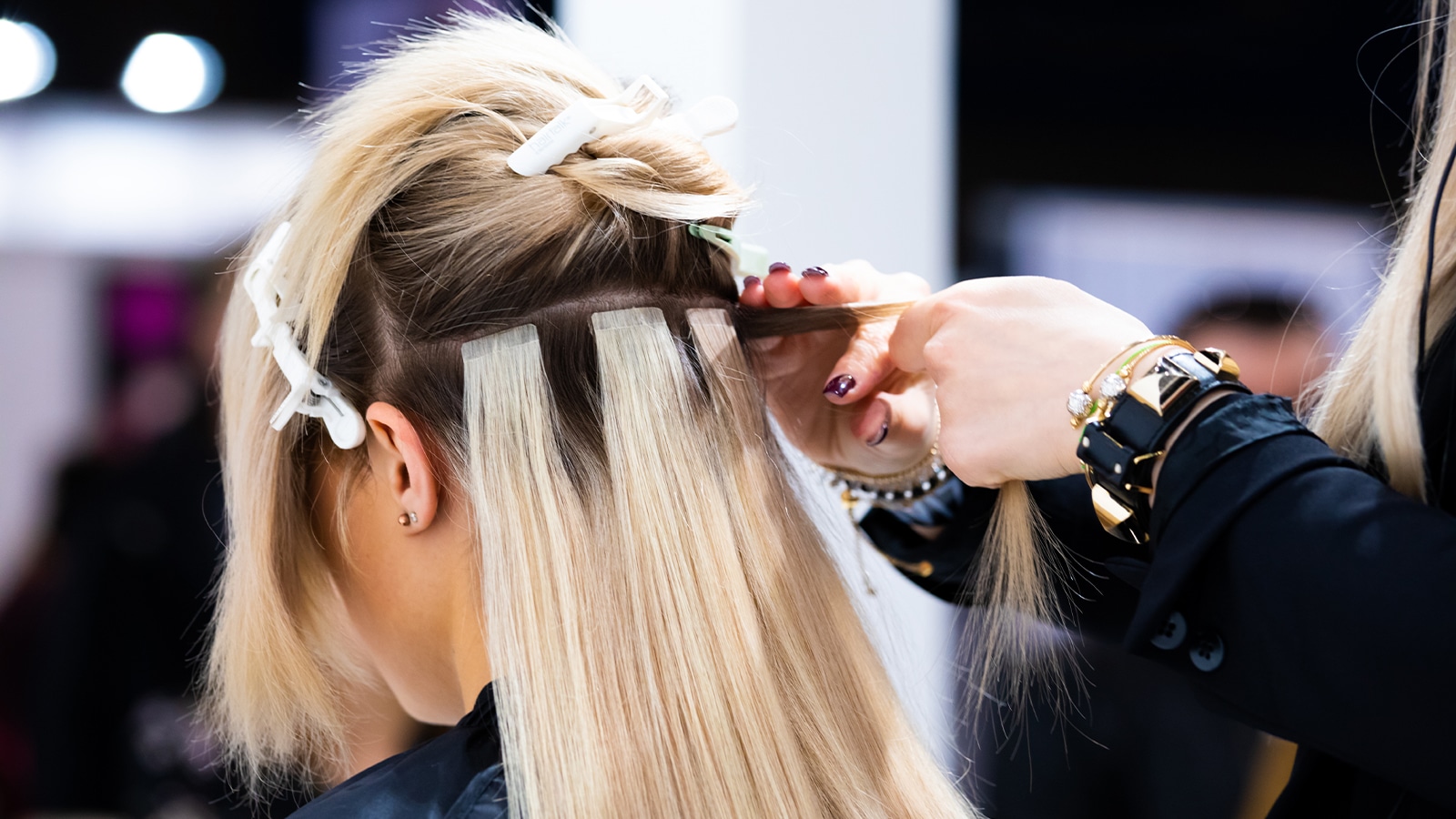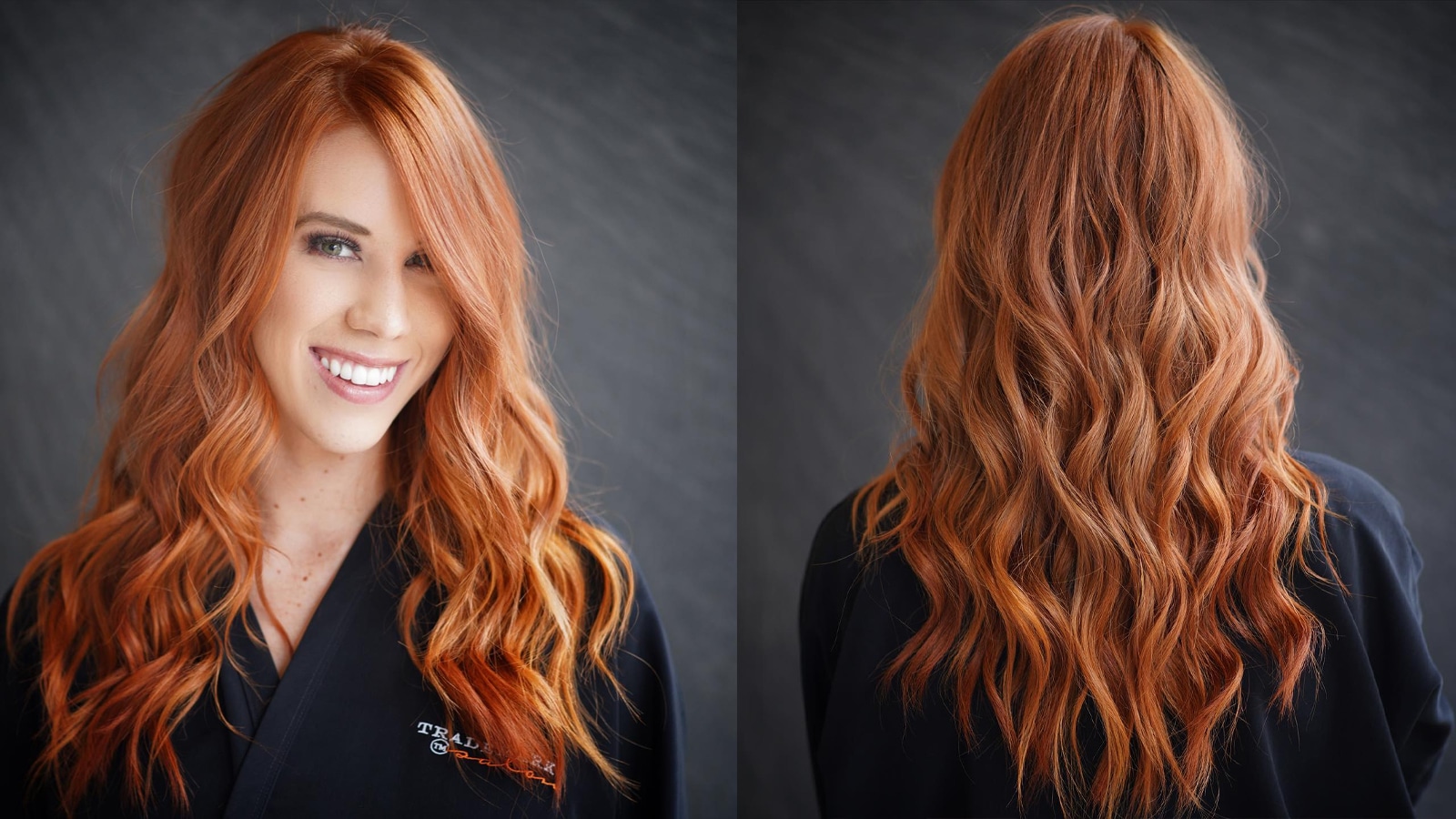 March 21, 2024 | Natural Beaded Rows
March 21, 2024 | Natural Beaded RowsNatural Beaded Rows vs Tape-In Hair Extensions
In the ever-evolving world of beauty and hair care, achieving the perfect volume and length is now more accessible and versatile than ever before, thanks to a wide array of hair extension methods available.
Among these, Natural Beaded Rows (NBR) and Tape In Hair Extensions stand out for their unique application techniques and benefits.
In this comprehensive guide, we’ll explore everything you need to know about these two popular methods, helping you make an informed decision for your next salon visit to the best hair salon near me in Houston, Trademark Salon.

Key Takeaways
- Natural Beaded Rows offer durability and discreetness for an undetectable finish.
- Tape-In Extensions provide a convenient, semi-permanent option for hair enhancement.
- Understanding the particulars of each method is key to achieving your desired look.
- Quality and technique matter when looking to maintain the health of your natural hair.
- Our professional insight can guide you towards the most suitable choice based on your hair type.
- It’s essential to weigh not just aesthetic appeal but also your everyday hair care routine.
- Finding the right match will lead you to gorgeously extended locks that feel as natural as they look.
Introduction
Embarking on the quest for fabulous hair, you’ve likely encountered the dilemma of choosing between natural-looking hair extensions such as Natural Beaded Rows and Tape-Ins.
Each method flaunts its own exclusive benefits and could be the key to unlocking your dream hairstyle. However, with every choice comes an array of pros and cons of hair extensions that deserve careful contemplation.
In this part of the article, we shall delve into the intricacies of NBR vs Tape-Ins, guided by the proficiency of Trademark Salon’s celebrated master NBR trainer Carlos Alvarez, revered for his exemplary work in NBR installations.
As you explore these popular hair extension options, you’ll want to consider not just aesthetics but also the practicalities that accompany each technique.
Your daily habits, hair care regime, and even the natural texture of your tresses play an integral role in determining which extension method will suit you best. Today’s discerning fashionista seeks extensions that promise longevity, minimal upkeep, and, crucially, a seamless bond with their natural hair.
- The allure of NBR lies in its capacity to enhance thickness and length without the tell-tale signs of artificial addition.
- Tape-In extensions, on the other hand, offer a swift and reversible pathway to volume and length, popular amongst those seeking a less permanent solution.
The choices at your disposal are as diverse as they are sophisticated. Keep reading as we unpack the attributes of tape-in vs. hand tied wefts so that you can choose to wear your new hair with pride and decide which extensions are better for you.
The Basics of Hair Extensions
Embarking on your hair extension journey can be exciting yet overwhelming. With so many hair extension techniques available, it’s important to familiarize yourself with the basics to make the best choice.
Whether looking at hair extension reviews or performing a hair extension cost comparison, understanding the foundation will guide your decisions for a seamless hair transformation to the right hair extensions.
Most hair extensions use high-quality Remy human hair, which preserves the hair cuticles and keeps the hair strands running in one direction.
This ensures they look natural with a texture that blends effortlessly with your own real hair. The hair extension marketplace offers a variety of attachment methods, such as clips, glues, tapes, and wefts, each suited for specific hair types and lifestyles.
Knowing the terminology used in hair extension descriptions can be incredibly beneficial.
Hand-tied wefts, for instance, refer to the technique where hair is manually tied onto a thin hair weft. This method provides flexibility and a natural drape against the scalp.
Adhesives, used in tape extensions, require careful application and removal to prevent damage to your natural hair.
Deciding on hair extensions doesn’t just end with choosing a style and a color. It’s about understanding and carefully considering the technique that will work best for you in the long run. Whether budget or commitment to care influences your choice, ensure it matches your individual needs and hair goals.
Understanding Natural Beaded Rows
As you explore the world of hair extensions, Natural Beaded Rows stand out for their ability to deliver both length and volume while maintaining a natural look that seamlessly integrates with your actual hair. This innovative method leverages the finest hand tied extensions that blend closely into your hair, utilizing a small row of beads and a lock technique to ensure a secure and comfortable fit.

What are Natural Beaded Rows?
NBR extensions are a type of hair enhancement that uses real human hair to amplify your hairstyle. Unlike other extensions that might use glue or heat, NBR relies on a unique method where beads are strategically placed along your scalp, and hand-tied wefts are then sewn into these rows. This method not only minimizes damage to your actual hair but also provides a fuller and more vibrant look.
The Process of Installing NBR
The installation process for NBR is an art in itself, requiring meticulous attention to detail and expertise. Highly skilled salon stylists, like those at Trademark Salon, section off the hair, carefully position the beads, and hand-tie each weft to the secure bead-and-lock base.
The result speaks for itself: a transformation that is as strong as it is delicate, offering a long-lasting and natural blend with your own tresses. This weft hair extension method is one of the best extensions options in the market.
Ideal Candidate for NBR Extensions
Wondering if you’re the right fit for NBR extensions? These hand-tied wefts are ideal for those with a desire for additional volume and length without sacrificing the health of their natural hair.
If you have a lifestyle that requires a low-maintenance yet chic look, or if you are looking for a semi-permanent hair extension solution that goes beyond the performance of clip-ins or tape-ins, NBR could be your perfect match.
Plus, with styles that can withstand regular washing and styling, NBR extensions cater to a dynamic, modern lifestyle while ensuring you look your absolute best.
Exploring Tape-In Hair Extensions
When seeking a balance between versatility, ease, and a gorgeous, fuller hairstyle, tape-in extensions are one of the most popular options.
Renowned for their ability to blend with your natural hair, they offer a semi-permanent solution for those desiring length and volume without the commitment of more permanent methods. Below we delve into the essence of tape ins, their installation process, and the prime candidates for this hair augmentation option.

What are Tape-In Extensions?
Tape hair extensions are renowned for their seamless blend with your natural strands. They consist of thin, hand-tied hair attached to a sticky adhesive strip. The tape-in method involves sandwiching small sections of your natural hair between these adhesive wefts, which then lay flat against the scalp for a comfortable and discreet fit.
A major benefit is the protection of hair health, as the method requires no heat or tools for installation.
The process of installing Tape-In Extensions
The application of tape-in hair extensions is straightforward and less invasive than other methods.
Your hairstylist will section your hair before applying the adhesive wefts near the roots but not directly onto the scalp to avoid irritation. Care is taken to ensure even distribution for a natural appearance, and the whole process can be completed in under an hour, a fraction of the time required for other hair extension techniques.
Ideal candidate for Tape-In Extensions
If you’re someone who values hair health and is looking for low-commitment but high-impact hair enhancements, tape-in extensions might be the perfect match for you. Especially suitable for those with thin or fine hair, tape-ins provide volume without the weight that can stress delicate strands.
Additionally, the maintenance routines for tape-in hair extensions are straightforward, involving regular gentle brushing, and using sulfate-free products to preserve both the extensions and the adhesive quality.
| Characteristics | Tape-In Extensions |
|---|---|
| Installation Time | Less than an hour |
| Natural Look | Seamless blend with hair |
| Suitability | Ideal for thin and fine hair types |
| Weight | Lightweight, minimal strain on roots |
| Maintenance Level | Low; easy at-home care |
| Maintenance Products | Sulfate-free shampoos and conditioners |
Benefits of Each Method
Choosing between tape-in and hand-tied extensions can significantly impact your overall satisfaction with the end result. Whether you have fine hair, require a specific hair type compatibility, or are looking for a particular hair extension method, understanding the advantages of each technique is crucial.
Below, find out how the durability of weft extensions and the particular methodology of hand tied hair extensions play a role in determining the right fit for your hair needs.
Advantages of Natural Beaded Rows
Natural Beaded Rows cater exceptionally well to those with fine hair, as the method employs a unique approach that doesn’t rely on glue or tape which can weigh down delicate strands.
The key to NBR’s success lies in its hand tied hair extensions, which are specifically designed to be lightweight and cause minimal stress to your natural hair, preserving its integrity.
NBR is renowned for its durability, making it a long-lasting investment in your hairstyle portfolio. They also last longer than tape.

- Seamless blend with natural hair texture
- Reduced visibility of extensions at the root
- Increased volume and length with minimal bulk
- Customizable for a tailored appearance
- Actual hair extensions can last longer than other types
Advantages of Tape-In Extensions
When it comes to ease of installation, Tape-In Hair Extensions are considered the reigning champion within the hair extension arsenal. Their methodology allows for a quick transformation, perfect for those looking for a temporary yet impactful change.
Tape-Ins offer a range of versatility for different hair types, not just exclusive to those with fine hair. The weft extensions used in this method come in varying widths, making them adaptable to individual needs and hair densities.
Additional advantages include:
- Minimal time required for application
- Low-profile bonds that lay flat against the head
- Opportunity for varied styling, including high ponytails
- Less commitment than some other hair extension methods
Challenges and Considerations
As you delve into the world of hair extensions, understanding the potential challenges and necessary considerations of each method is paramount.
While Natural Beaded Rows (NBR) and Tape-In Extensions offer exciting possibilities for achieving the thick hair or volume you’ve been dreaming of, they come with their own sets of drawbacks. An informed choice necessitates a grasp of the longevity, compatibility with thin hair or thick hair, and the specific type of extensions best suited for maintaining your hair healthily.
The Drawbacks of Natural Beaded Rows
Natural Beaded Rows provide a luxurious and full appearance but they aren’t free from drawbacks.
Despite being a reliable option for those with thin hair seeking to add volume without excess strain, the meticulous maintenance required to keep NBR looking fresh can be considerable.
Regular salon visits are essential for upkeep, and if not managed properly, there could be increased tension on the scalp leading to potential discomfort or damage over time.
The cost of the hair extensions tends to be a little higher.
The Drawbacks of Tape-In Extensions
Tape-In Extensions have their limitations as well. While they’re known for being a less intrusive method and suitable for a range of hair types, including thick hair, the glue or tape can pose a risk.
The adhesive may cause damage if left on for too long or if removed improperly. Furthermore, these extensions typically don’t last as long as some alternatives and require frequent reapplication—approximately every six to eight weeks—making them a commitment in both time and maintenance.
| Extension Type | Pros | Cons | Ideal for | Maintenance Frequency |
|---|---|---|---|---|
| Natural Beaded Rows | Suitable for thin hair, less scalp strain, natural look | Routine maintenance, potential for discomfort | Thin hair types | Every 6-8 weeks |
| Tape-In Extensions | Quick application, varied hair type compatibility | Adhesive damage risk, more frequent reapplications | Thick and thin hair types | Every 4-6 weeks |
Summary
Embarking on your journey to achieve gorgeous hair can be thrilling, especially with the wealth of options available.
Throughout this comparison of Natural Beaded Rows and Tape-In Extensions, we’ve endeavored to unveil the multitude of facets each technique offers to meet your hair goals. NBR caters to those seeking a durable method that blends seamlessly with your natural hair, providing volume and length that coexists with your hair’s growth. Alternatively, installing tape in extensions presents a versatile solution that adapts to various lifestyles, offering a semi-permanent fix that’s easy to maintain.
Whether your inclinations lean towards the sophistication of NBR or the practical charm of Tape-Ins, both approaches promise to revolutionize your look. Each has its set of benefits and considerations, from the careful beadwork of NBR to the adhesive finesse of Tape-Ins.
Remember, the ideal choice is one that not only compliments your personal aesthetic but also respects the integrity of your hair’s health and encourages hair growth.
As you mull over these insights, consider not just the immediate allure but how your decision will influence your hair’s future.
Finesse meets functionality in both NBR and Tape-In Extensions, and your preference should align with the care routine you’re passionate about upholding. May your decision guide you to a hair transformation that feels as authentic as you are, imbued with lasting beauty and strength.
Do you need help with your extensions? Schedule a consultation with us today!
Frequently Asked Questions
What are the main differences between Natural Beaded Rows and Tape-In Extensions?
The main differences lie in the application methods and the type of commitment involved. Natural Beaded Rows (NBR) utilize a bead and string technique to create a weft that is sewn into your natural hair, offering a more permanent solution. Tape-In Extensions use adhesive tape to attach thin wefts near the scalp and are considered semi-permanent.
Are Natural Beaded Rows or Tape-In Extensions better for fine hair?
Natural Beaded Rows can be excellent for fine hair since they distribute weight evenly and minimize strain on delicate strands. Tape-In Extensions are also suitable for fine hair as they lie flat against the head and can blend seamlessly without adding excessive weight.
How long do these hair extension methods typically last?
Natural Beaded Rows can last 4-6 months or longer with proper maintenance and regular adjustments. Tape-In Extensions generally need to be re-applied every 6-8 weeks as your natural hair grows out.
Can I style my hair normally with either NBR or Tape-In Extensions?
Yes, both NBR and Tape-In Extensions allow you to style your hair as usual, including using heat tools and putting your hair up. However, certain styles may require specific techniques to ensure the extensions remain hidden and secure.
What is the cost comparison between the two hair extension methods?
Natural Beaded Rows are often more expensive initially due to the detailed hand-tied weft application process. Tape-In Extensions are generally less costly upfront, but since they require more frequent reapplications, the overall investment may be similar over time.
Which hair extension method looks more natural?
Both methods can look very natural when applied by a skilled stylist. NBR extensions are known for their ability to blend seamlessly for a fuller look, while Tape-Ins can also provide a natural appearance with the right color and texture match.
What should I consider when choosing between NBR and Tape-In Extensions?
Consider your lifestyle, hair type, maintenance commitment, and budget. Natural Beaded Rows typically require less frequent maintenance visits, while Tape-Ins may be better for those seeking a less permanent option. Always consult with a professional stylist to determine the best choice for your needs.
How do I maintain my hair extensions to ensure they last longer?
To maintain your hair extensions, follow a tailored hair care routine that includes using extension-friendly products, avoiding excessive heat styling, and sleeping with your hair in a loose braid or ponytail. Regular salon visits for maintenance are also crucial for both NBR and Tape-In Extensions.
Will hair extensions cause damage to my natural hair?
When applied and maintained correctly by a certified professional, both Natural Beaded Rows and Tape-In Extensions should not cause significant damage to your natural hair. It’s vital to follow your stylist’s care instructions and attend maintenance appointments to prevent potential stress on your hair.
Can I wash and dry my hair as usual with extensions in?
Yes, but you’ll need to be gentle. Use sulfate-free shampoos and conditioners, avoid scrubbing the bonds or wefts, and pat your hair dry rather than rubbing. With Tape-In Extensions in particular, it’s important to wait 48 hours after application before the first wash to allow the adhesive to set properly.
